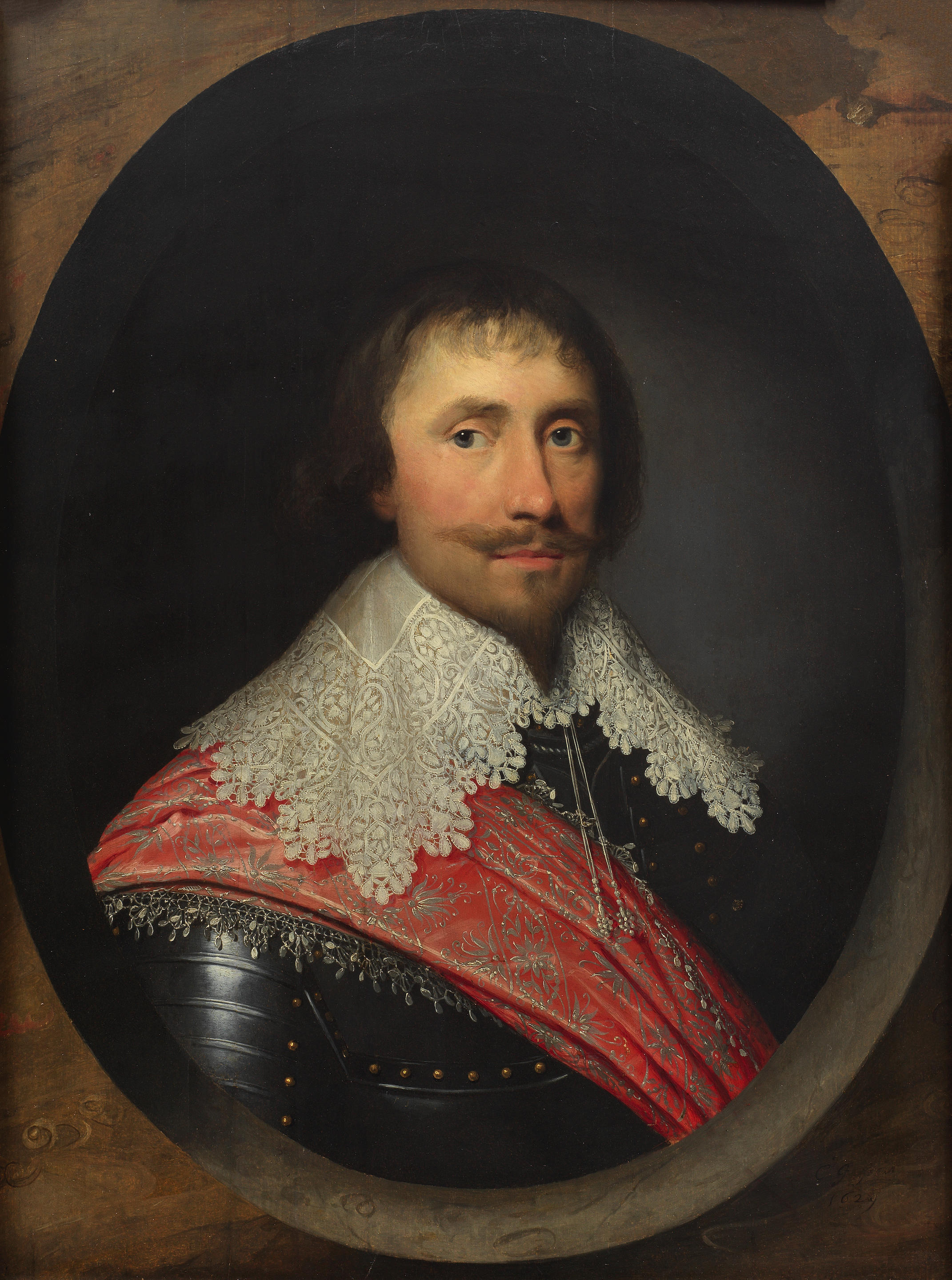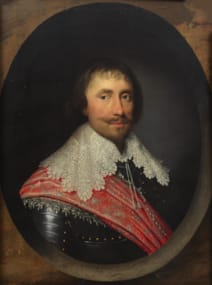
ornelis Jonson van Ceulen
(London 1593 - Utrecht 1661)
 Biography
Biography Portrait of Robert de Vere, 19th Earl of Oxford, bust-length, in armour with a lace collar and red sash, within a painted oval
Biography
Jonson van Ceulen is described as an English painter of Flemish descent who lived in the northern Netherlands. His grandfather Peter Jansen originally came from Cologne, which explains the family's surname, and his parents had fled religious persecution in Antwerp to settle in London. In 1622 he married Elizabeth Beck of Colchester, a woman of Dutch origin who bore him two sons. The couple are portrayed with their son, Cornelis van Ceulen II (1634–1715), in a portrait by Adriaen Hanneman (c. 1637; Enschede, Rijksmuseum Twenthe).
Cornelis was successful in London, producing several hundred portraits between 1619 and around 1640, primarily of members of the wealthy merchant classes. Jonson is the first English-born painter known to have produced such a large number of signed portraits. Although he was certainly not a pace-setting portrait painter in early Stuart London, he still received many commissions. In addition to original paintings, he produced copies after the work of other artists, for example a monogrammed copy (1631; Chatsworth, Derbyshire) of the portrait of Charles I by Daniel Mijtens I (1629; New York, Metropolitan Museum). Since Jonson signed the painting it is clear that he was not simply one of Mijtens’s studio assistants but rather an independent painter who was commissioned, either through Mijtens or directly, to copy the original. This type of work probably explains the mention of him in 1632 as ‘his Majesty’s servant in the quality of Picture drawer’.
Most of Jonson’s original works during his London period are portraits of people in the higher, but not the highest, social circles. A large majority of these portraits are busts, simple in composition and ably reproducing the sitters’ features. Some are set in a trompe l’oeil oval, painted to imitate a stone niche. Many of these bust portraits are in English public, and particularly private, collections, for example the portrait of Sir Thomas Hanmer (1631; Cardiff, National Museum) and the two small pendants Portrait of a Man and Portrait of a Woman (c. 1629; London, Tate).
In spite of Jonson’s somewhat conservative style, he absorbed some influence from such artists as Daniel Mijtens I and Anthony van Dyck, particularly in his more ambitious works, such as the three-quarter-length portraits that he painted regularly and the group portrait of the Family of Arthur, Lord Capel (c. 1639; London, National Portrait Gallery), which is strongly inspired by van Dyck. In addition to large-scale paintings, Jonson also produced miniatures in oil on copper, including some signed examples, such as the Portrait of a Man (1639; Welbeck Abbey, Notts, see 1972 exh. cat., no. 205) and the portraits of Peter Vanderput and his wife Jane Hoste (London, Lord Thomson of Fleet private collection; see London, Sotheby’s, 6 March 1967, lot 75). Some of the miniatures are reduced reproductions of full-size paintings.
The painter and his household left England in 1643 at the start of the Civil War, settling first in Middelburg. In 1646 Jonson was living in Amsterdam while he painted a large group portrait of the Magistrates of The Hague (1647; The Hague, Oude Stadhuis). In subsequent years he painted portraits of the citizens of various Dutch cities, including Middelburg, suggesting that he led an itinerant life for some time. His final place of residence was probably Utrecht.
In the many portraits produced during his Dutch period, Jonson brought his personal style to its greatest perfection. Besides a few group portraits, his paintings were primarily half-length and three-quarter-length portraits notable for their elegance and their accurate rendering of the sitter’s features and clothing. The paintings frequently use blue and green backgrounds, not a practice fashionable at the time. Representative examples of Jonson’s later portrait paintings include Jasper Schade and Cornelia Strick (both 1654; Enschede, Rijksmuseum Twenthe); the Portrait of a Woman (1655; London, National Gallery); Prince William III of Orange Nassau as a Child (1657; Knole, Kent, NT); and the Portrait of a Woman (1659; London, Tate). Jonson’s most important student was his son Cornelis II, whose style initially resembled his father’s but whose later work declined sharply to a mediocre level.
Collections
Van Ceulen is represented in the following collections: National Gallery, London; National Portrait Gallery, London; Tate Gallery, London; Courtauld Institute of Art, London; Ashmolean Museum at the University of Oxford; Fitzwilliam Museum at the University of Cambridge; Boughton House, Northamptonshire; Metropolitan Museum of Art, New York; Indianapolis Museum of Art, Indiana; Museum of Fine Arts, Houston, Texas; Museum of Fine Arts, Boston; Art Gallery of South Australia, Adelaide; Christchurch Art Gallery Te Puna O Waiwhetu, New Zealand, amongst others.










